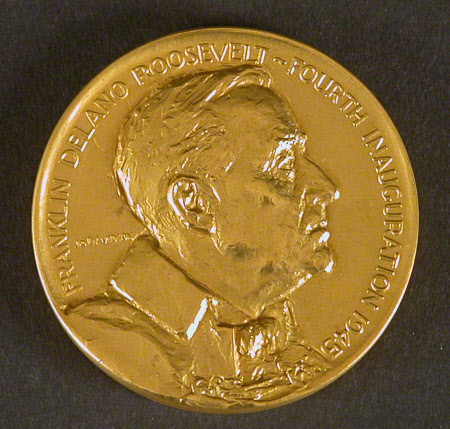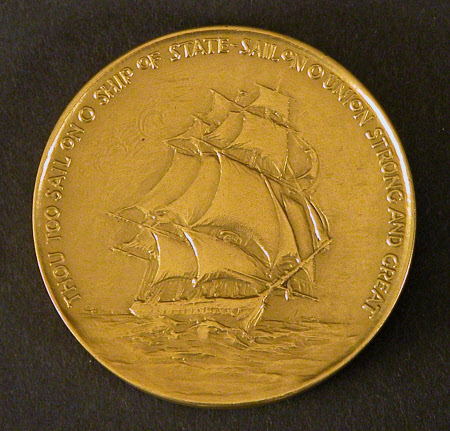Commemorative medal
Jo Davidson (New York City 1883 - Paris 1952)
Category
Coins and medals
Date
1946
Materials
Gold
Measurements
4 mm (Height); 45 mm (Diameter)
Order this imageCollection
Chartwell, Kent
NT 1101176
Summary
Gold medal struck for the fourth Inauguration Ceremony 1945, with a bust of Roosevelt, the reverse with Longfellow's "Ship of State" and inscription, the portrait by Jo. Davidson. Formerly part of the Heirloom Collection.
Full description
Roosevelt’s 4th Inauguration was held on 20 Jan. 1945. FDR died in April 1945. As a final lifetime memento of the relationship between Churchill & FDR this is a remarkable item. It was given by Roosevelt to Churchill at the Yalta Conference, with Roosevelt also giving one to Stalin. The Chicago Tribune reported on 1 March 1945, “And now we come to Mr. Roosevelt’s gifts at Yalta to Mr. Churchill and Mr. Stalin which took the form of the fourth inauguration medal cast in fine gold. It would embarrass Mr. Roosevelt to express in words to his colleagues how heavily he was indebted to them for the fourth inauguration. The medal told Mr. Churchill that the good work done by his Anglophile following on the seaboard had not been overlooked. The copy to Mr. Stalin told him the same story as to his Browders and his PAC. The substance of which the medal was cast could convey the thought that there is gold for such helpful allies in them thar elections. We should like to think that Mr. Roosevelt was hinting that in this country elections are held, war or no war. It’s 10 years since they’ve had one in Britain and they’ve never had a real one in Russia”. Historical Note to an inscription on a Medallion presented to Sir Winston Churchill after attending the Yalta Conference. In the dark early years of the Second World War when the British Empire and its commonwealths stood alone against Germany a very dramatic document, which takes us straight back to the critical period of the forging of the Atlantic Alliance between Churchill and Roosevelt. It is 27 January 1941. The United Kingdom, under Churchill’s leadership, has survived the Battle of Britain and the Blitz. Yet the situation is precarious. The Battle of the Atlantic has not been won, Europe is dominated by Nazi Germany, the Luftwaffe is bombing British cities, the Soviet Union is still bound to Germany by the terms of the Molotov-Ribbentrop Pact, and the United States is neutral and is not yet committed to the Lend–Lease programme. Imagine, then, the psychological effect of the delivery of a letter to Churchill. It had been written by hand by Franklin Delano Roosevelt just seven days earlier on 20 January 1941, Inauguration Day for his unprecedented third term as American President. Roosevelt was a man whom Churchill had not met since 1918. But Roosevelt was also the man on whom Churchill pinned all real hope of obtaining ultimate victory in his war against Hitler. The letter reads as follows: “Dear Churchill Wendell Wilkie will give you this – He is truly helping to keep politics out over here. I think this verse applies to you people as it does to us: ‘Sail on, oh ship of state! Sail on Oh Union strong and great. Humanity with all its fears, With all the hope of future years Is hanging breathless on thy fate’ As ever yours, Franklin d Roosevelt” There was clearly much for Churchill to like here. On a personal level, he would have liked the intimacy being shown by Roosevelt: the fact that the President not only wrote out the letter by hand but also the accompanying envelope. The tone of the verse by Longfellow would have appealed to Churchill's romantic nature and sense of history. Yet it must have been the political message being sent by Roosevelt that would have pleased Churchill the most. For it was no accident that this letter was entrusted to Wendell Willkie. Willkie had run against Roosevelt as the Republican candidate in the 1940 Presidential election, but shared Roosevelt’s views on the need to support Britain. His mission to see Churchill, with this letter of introduction from Roosevelt, was a clear statement of bi-partisan support for Britain, and an indication, through its deliberate linking of the British cause with that of the United States, that Roosevelt might now be prepared to offer more than a few old destroyers. It is clear that Churchill recognised the importance of this document. He chose to reproduce it in volume III of his history of The Second World War, where he commented: “These splendid lines from Longfellow’s ‘Building of the Ship’ were an inspiration”, and he immediately telegraphed to Roosevelt to say that: “I received Wilkie yesterday, and was deeply moved by the verse of Longfellow’s which you had quoted. I shall have it framed as a souvenir of these tremendous days, and as a mark of our friendly relations, which have been built up telegraphically but also telepathically under all the stresses”. The faded appearance of this document, from White House green to brown, is a testament to the fact that Churchill was as good as his word - the letter was framed, and hung for a long time at Chartwell.
Marks and inscriptions
Longfellow's "Ship of State" and inscription on reverse
Makers and roles
Jo Davidson (New York City 1883 - Paris 1952), designer

